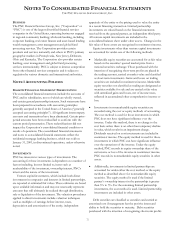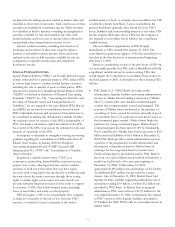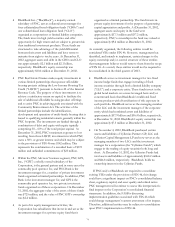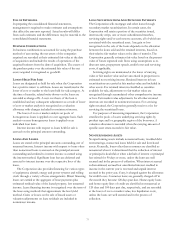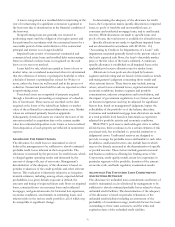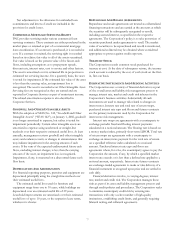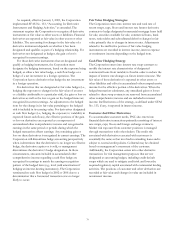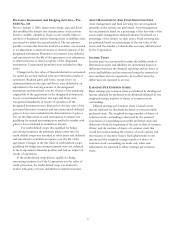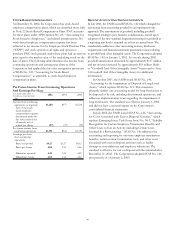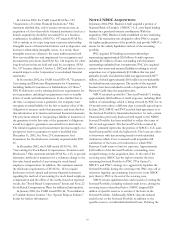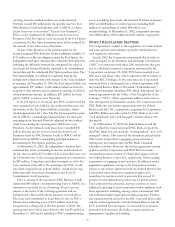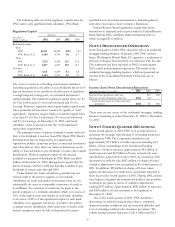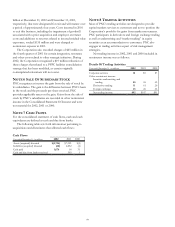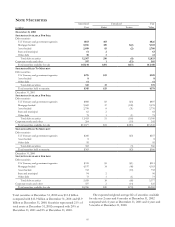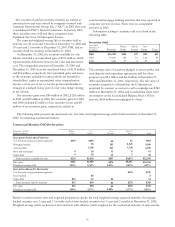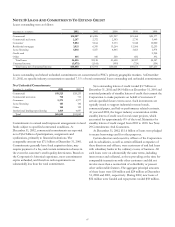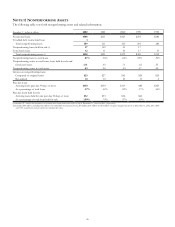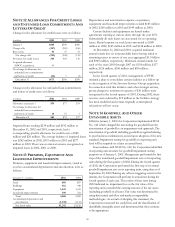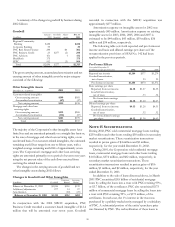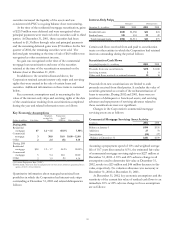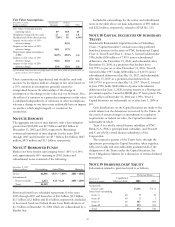PNC Bank 2002 Annual Report Download - page 84
Download and view the complete annual report
Please find page 84 of the 2002 PNC Bank annual report below. You can navigate through the pages in the report by either clicking on the pages listed below, or by using the keyword search tool below to find specific information within the annual report.82
servicing term the realized credit losses in the Serviced
Portfolio exceed $50 million plus the specific reserves, then
PNC Business Credit will advance cash to NBOC for these
excess losses net of recoveries (“Excess Loss Payments”).
PNC is to be reimbursed by NBOC for any Excess Loss
Payments if the Put Option is not exercised. If the Put Option
is exercised, the Put Option purchase price will be reduced by
the amount of any Excess Loss Payments.
As part of the allocation of the purchase price for the
business acquired, PNC Business Credit established a liability of
$112 million to reflect its obligation under the Put Option. An
independent third party valuation firm valued the Put Option by
estimating the difference between the anticipated fair value of
loans from the Serviced Portfolio expected to be outstanding at
the put date and the anticipated Put Option purchase price. The
Put Option liability is revalued on a quarterly basis by the
independent valuation firm with changes in the value included
in earnings. At December 31, 2002 the Put Option liability was
approximately $57 million. A $28 million reduction from the
acquisition date amount was recognized in earnings in 2002 as
other noninterest income. In addition, $27 million has been
paid to NBOC as Excess Loss Payments.
If the Put Option is exercised, then PNC would record the
loans acquired as loans held for sale at the purchase price less
the balance of the Put Option liability at that date, which
should approximate fair value. The Put Option purchase price
will be NBOC’s outstanding principal balance for the loans
remaining in the Serviced Portfolio adjusted for the realized
credit losses during the servicing term and Excess Loss
Payments. As the realized credit losses have exceeded $50
million plus the specific reserves used, the Excess Loss
Payments made by PNC Business Credit to NBOC will be
deducted from NBOC’s outstanding principal balance in
determining the Put Option purchase price.
At December 31, 2002, the independent valuation firm
estimated that loans outstanding in the Serviced Portfolio at
the put date would be $175 million. The total credit losses over
the 18-month term of the servicing agreement are estimated to
be $87 million. Using these and other assumptions, if the Put
were exercised at the end of the servicing term, PNC would
record the acquired loans at $114 million. Actual results may
differ materially from these assumptions. See Note 29
Commitments And Guarantees.
Prior to closing of the acquisition, PNC Business Credit
transferred $49 million of nonperforming loans to NBOC in a
transaction accounted for as a financing. Those loans are
subject to the terms of the servicing agreement and are
included in the Serviced Portfolio amounts set forth above.
The loans were transferred to loans held for sale on PNC’s
balance sheet reflecting a loss of $9.9 million, which was
recognized as a charge-off in the first quarter of 2002. The
carrying amount of those loans held for sale was $5 million at
December 31, 2002 and is included in PNC’s nonperforming
assets. Excluding these loans, the Serviced Portfolio in January
2002 was $608 million of credit exposure including $414
million of outstandings of which $88 million was
nonperforming. At December 31, 2002, comparable amounts
were $249 million, $183 million and $53 million, respectively.
NOTE 3 REGULATORY MATTERS
The Corporation is subject to the regulations of certain federal
and state agencies and undergoes periodic examinations by
such regulatory authorities.
In July 2002, the Corporation announced that in order to
settle an inquiry by the Securities and Exchange Commission
(“SEC”) in connection with three 2001 transactions that gave
rise to a financial statement restatement announced by the
Corporation on January 29, 2002, PNC had consented to an
SEC cease and desist order. The Corporation did not admit or
deny the SEC’s findings. At the same time, the Corporation
announced that it had entered into a written agreement with
the Federal Reserve Bank of Cleveland (“Federal Reserve”)
and that its principal subsidiary, PNC Bank, had entered into a
written agreement with the Office of the Comptroller of the
Currency (“OCC”). These agreements address such issues as
risk, management and financial controls. The Corporation and
PNC Bank also entered into agreements with the Federal
Reserve and the OCC, respectively, requiring the Corporation
and PNC Bank to provide a plan for PNC Bank to meet the
“well capitalized” and “well managed” criteria within a 180-
day period.
As of December 19, 2002, the Federal Reserve and the
OCC notified the Corporation and PNC Bank, respectively,
that PNC Bank now met both the “well capitalized” and “well
managed” criteria. This removed the limitations placed in July
2002 on the Corporation’s engaging in new activities or
making new investments and on PNC Bank’s financial
subsidiary activities. However, the written agreements remain
in place, and the Corporation and PNC Bank in certain
circumstances must continue to obtain prior approval from
the Federal Reserve or the OCC, respectively, before making
acquisitions or engaging in new activities. In addition, under
applicable regulations, as long as the Corporation remains
subject to the written agreement with the Federal Reserve, the
Corporation must obtain prior regulatory approval to
repurchase its common stock in amounts that exceed 10
percent of consolidated net worth in any 12-month period.
The Corporation has incurred, and may continue to incur,
additional operating costs in connection with compliance with
these agreements including, among others, incremental staff
and continued higher legal and consulting expenses. Further,
the reputational risk created by the SEC cease and desist order
and the written agreements with the Federal Reserve and the
OCC could still have an impact on such matters as business
generation and retention, the ability to attract and retain
management, liquidity and funding.


